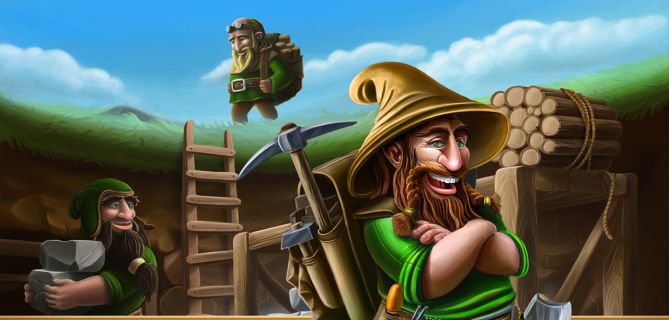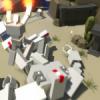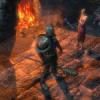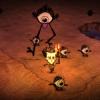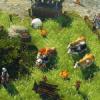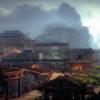It’s amazing that in an age where social media sends news of incredible scientific discoveries, world news, and cute kitten memes to the masses in an instant, a Steam Early Access game with awesome potential has been relatively unheard of among the wider gaming community.
Craft the World by Dekovir Entertainment, published by Black Maple Games, was released on Early Access on November 19, 2024 with version 0.9.003. While it’s still a long way off from its final release, Craft the World is a solid piece of work with stellar graphics, wonderful musical accompaniment, and a refreshing mixture of crafting, RPG, strategy, and tower defense characteristics that make it one of the best Early Access games we have ever played.
At its core, Craft the World is a crafting game. It’s a God-like RPG, reminiscent of the old Populous, where you are in charge of a tribe of Dwarfs and can issue commands to build structures and objects, dig tunnels and mine minerals, and attack enemies that will, at regular intervals, attempt to steal your item cache and kill your workers. In the beginning, you start with one lonely Dwarf, and each level you gain increases your dwarf population by one; the more Dwarfs you have, the more work you can do.
There’s no real story - at least, not in the sense that most RPG veterans are used to. You’re simply plopped on a planet and expected to survive. Rather than controlling your own sprite, however, you issue commands that your dwarf population then carries out according to a structured hierarchy of importance. What you are given, thankfully, is a quest book that regularly updates as you progress, and it begins with very simple instructions: Chop a tree. Sure, we can handle that.
As you chop trees, bushes, and wheat, and as you dig out dirt, sand, and rock, you accumulate materials in your inventory. Opening the inventory leads you to discover the crafting tree as well as one of the most unique aspect of Craft the World that really make is a cut above other games we have played recently. Clicking on a recipe on shows what materials are needed to make an item, as well as what orientation those materials need to be placed in. It’s refreshingly intuitive and we are surprised that we haven’t seen something like it in other crafting games before now.
The early goals of your civilization will be to gather materials and create a dwelling. We say “dwelling” because a house implies that you will need to build above ground, but in the early game just digging a hole in the ground and covering it with a hatch will create a sufficient home for your Dwarfs. Placing a bed inside this simple hole in the ground will be enough to encourage your dwarf to sleep in order to recover health, and be comfortable enough to eat and hang out. It is essential to create some kind of dwelling within the first few nights, as each night as the sun sets and the music becomes more ominous, waves of skeletons and zombies will make their way toward your dwelling and your inventory stash with the intent of stealing your stuff and outright killing your Dwarfs. Here is where the tower defense really comes into its own, as you come to learn that the waves of creepy crawlies will come for you every night and get progressively harder as you go, so crafting stronger defenses, a better home, and improved equipment for your Dwarfs is essential during the daylight hours.
In addition to the nightly waves, a timer at the top of the screen counts down every 45 minutes after your first skeleton wave. When the countdown is completed, a portal opens begins to spew out skeletons, zombies, and a boss-like monster at the end. It’s a larger wave than the standard nightly one and will put your fighting skills to the test. Don’t worry if a Dwarf dies here and there, though - and get over that compulsion to start over. The deceased will respawn in about two minutes.
Speaking of equipment, Dwarfs can be equipped with a mining tool, a chopping tool, a weapon, armor, helmet, boots, and an accessory. There are also has three skills they can obtain, including mining, smithing, cooking, etc. These are improved by doing that particular task, and empty skill slots can be filled when a dwarf unearths a book. In addition to digging up skill books, Dwarfs will occasionally find gold which is used to purchase materials that can be harder to find.
One aspect that has developed is crafting. Early stages were very similar to the current game play, but the crafting tree seemed arbitrary. It began as a single linear path that had a few branches far down the tree, and the order of certain items didn’t make any sense; crafting an iron door before a wooden table, for example, when the player might not have discovered iron ore yet but certainly had plenty of wood. Another early problem was the lack of renewable resources, mainly trees and bushes. If you accidentally chopped down the last tree or the last bush on a section of flat land, you were out of luck; you needed to leave at least one remaining for others to germinate. Two changes have vastly improved this problem. The tech tree is now a four row high grid, and there’s a wider range of options to craft items to unlock another section of the tree. Each segment also has a set amount of experience that you will need to earn in order to progress to the next. The second excellent fix was the increased rate of resource growth and respawn without the need to keep a tree or a bush handy in order to promote new growth.
Evoking memories of Populous and Black & White is the addition of spells, from a magic portal (which is invaluable) and a magic light, to more complicated ones like a rally cry to gather your Dwarfs for an attack, or even a forest-generating spell. These spells are part of the tech tree, and require mana to cast. Mana is regained over time and your pool increases as you level.
Perhaps the best feature that Craft the World boasts is the commitment of its developer and the attention paid to the Steam community. Since its original release, there’s been some amazing art improvement, UI upgrades, countless tweaks, additions and fixes. Update intervals have been about every 15-30 days, each with some significant enhancements, and hot fixes have been quick down the pike if an update caused massive problems for a number of players.
There are still some minor bugs that we’re sure are being worked on, such as the occasional freeze, or the inability of a dwarf to decide to cut the tree he is standing directly in front of him, even though we’ve told him to do it countless time. Still, what issues we have encountered are minor.
Craft the World is shaping up to be a solid addition to a growing genre, and we can’t wait to see the final release. If a game can be this good in Early Access, just imagine what we can expect when it’s finished.

